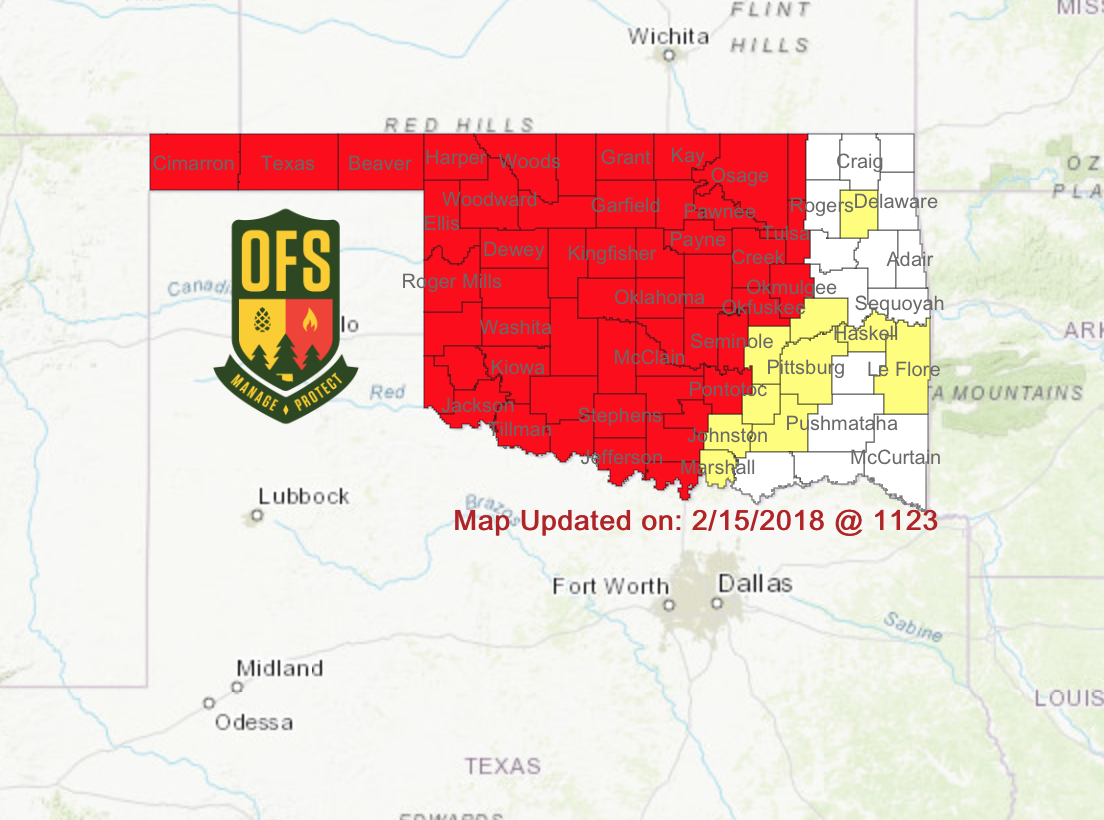Oklahoma Forest Services reported Feb. 19 the Red Horse Fire in Woods County has burned an estimated 3,600 acres and is 10 percent contained. The fire is nearest to Freedom, Oklahoma, in the northwest part of the state or west of Alva, Oklahoma. There are about 150 OFS and other personnel working to contain the fire. It started late in the afternoon Feb. 18. The cause has yet to be determined.
This is the first major wildfire of 2018 for the area, but it could be an active wildfire season. Areas of western Oklahoma, Texas and Kansas have not had measurable precipitation in months—and there is ample grass fuel left over from last year. According to the Oklahoma Mesonet, Freedom hasn’t received any rainfall in the last 180 days.
In response to the Red Horse Fire, OFS has sent its task force, including an air attack platform, a type 1 airtanker and aerial supervision module and two type 1 helicopters, and an Oklahoma Highway Patrol/OFS aerial observation platform to the scene.
Marty Logan, storm tracker for KWTV News9, reported on social media Feb. 18 the fire was not under control and he didn’t expect it to be controlled during the night because of southwest winds from 20 to 30 mph. He estimated the fire to be 9 miles long and up to 1 mile wide in places. Firefighting units from Kansas have been in the area, and Logan estimated 50 to 100 fire units, numerous graders and dozers.
Woods County is one of 52 Oklahoma counties currently under a burn ban by Gov. Mary Fallin. On Feb. 15 she extended and expanded a burn ban because of “extreme and extraordinary fire danger.”
According to the OFS, a Red Flag Warning is in effect for Cimarron County Feb. 19 from noon through 7 p.m. A cold front that pushed into northwest Oklahoma early Feb. 19 aided in improving overnight moisture recovery, facilitating good progress on the large fires in northwest Oklahoma. A challenging fire weather forecast is predicted for Feb. 19, but elevated fire danger concerns will persist across the Panhandle and northwest Oklahoma as well as expansion into parts of western and southwestern Oklahoma.
The highest fire danger concerns will be in the Panhandle Feb. 19 as temperatures warm to 65 to 68 degrees Fahrenheit with relative humidity values 19 to 30 percent. The frontal boundary that has pushed in from Kansas earlier in morning Feb. 19 is expected to fade back, opening the door for winds to switch back to the south. Wind speeds 20 to 30 mph gusting in excess of 35 mph will encourage rapid fire growth as fine fuel moisture values tap 4 to 5 percent.
A stalled cold front in northwest Oklahoma is expected to present improved conditions compared to Feb. 18. Nonetheless, very dry fuels will support active fire behavior. And, as was witnessed Feb. 18, continued resistance to fire suppression should be expected. A stalled cold front may keep northerly winds in place through the day and strongest during the first half of the day. But, should the front retreat, expect fire danger to increase into the afternoon and evening hours. That said, temperatures in the low- to mid-60s with some sky cover and relative humidity values 28 to 32 percent will deliver fine fuel moisture values around 6 percent. Rates of fire spread will remain classified as rapid Feb. 19, but opportunity for successful initial attack is increased.
In a news release, it was reported environmental conditions have continued to deteriorate since the initial ban was issued Jan. 30. The governor’s burn ban supersedes any county burn bans and will remain in place until midnight March 2. Additionally, several counties in eastern Oklahoma remain under county commissioner-issued bans.
“Drought conditions continue to worsen across the state with no measurable rainfall occurring in the western third of Oklahoma for the past 130 days, and central Oklahoma is approaching 40 days without rain,” said Fallin in the news release. “An expanded burn ban is called for to reduce the risk of preventable wildfires and to protect lives and property.”
The governor’s ban covers 52 counties: Alfalfa, Beaver, Beckham, Blaine, Caddo, Canadian, Carter, Cimarron, Cleveland, Comanche, Cotton, Creek, Custer, Dewey, Ellis, Garfield, Garvin, Grady, Grant, Greer, Harmon, Harper, Jackson, Jefferson, Kay, Kingfisher, Kiowa, Lincoln, Logan, Love, Major, McClain, Murray, Noble, Okfuskee, Oklahoma, Okmulgee, Osage, Pawnee, Payne, Pontotoc, Pottawatomie, Roger Mills, Seminole, Stephens, Texas, Tillman, Tulsa, Washington, Washita, Woods and Woodward. For the most updated list, visit www.forestry.ok.gov/burn-ban-info.
Kylene Scott can be reached at 620-227-1804 or [email protected].


